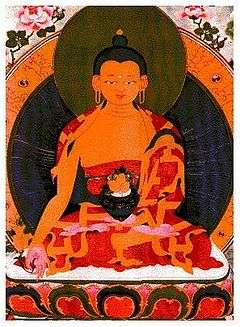Prabhutaratna
| Prabhutaratna | |
|---|---|
 Abundant Treasures Buddha | |
| Sanskrit | प्रभूतरत्न Prabhūtaratna |
| Chinese | 多寶 (Duō băo) |
| Japanese | 多宝如来 (Tahō Nyorai) |
| Korean | 다보 (Dabo) |
| Tibetan | རིན་ཆེན་མང་ rin chen mang |
| Information | |
| Venerated by | Mahayana, Vajrayana |
| Attributes | Witness to the Lotus Sutra |
|
| |
| Part of a series on |
| Mahāyāna Buddhism |
|---|
 |
|
Teachings |
|
Mahāyāna schools |
|
|
Prabhūtaratna (Skt: प्रभूतरत्न; Traditional Chinese: 多寶; Simplified Chinese: 多宝; pinyin: duō bǎo; Japanese: 多宝如来 Ta takara nyorai or Tahō nyorai), also known as Abundant Treasures, is the Buddha whom Shakyamuni is closely associated with in the Threefold Lotus Sutra, namely in the Lotus Sutra itself and the Samantabhadra Meditation Sutra.
In the Lotus Sutra
In the 11th chapter of the Lotus Sutra, Prabhūtaratna is depicted as seated next to Shakyamuni Buddha within the stupa of Abundant Treasures Buddha, to whom all the buddhas from the "ten directions," and those in the great assembly, come to hear the Dharma,[1] and is said to reside in a land "tens of millions of billions of countless worlds to the east" called "Treasure Purity".[2]
Within a stupa called "Precious Stupa," or the "Stupa of the Precious Seven Materials", is where Prabhūtaratna resides and in which he appears to manifest himself when bearing witness to the Lotus Sutra of the Wonderful Dharma.[3] This stupa is believed to symbolize buddha-nature which all people possess, while the springing-up of the stupa from the earth is said to imply the discovery of one's own buddha-nature.[4]
Prabhutaratna made a vow that when the Lotus sutra was preached his stupa containing his relics would appear from below the earth. When Gutama Buddha opened the stupa Prabhutaratna was apparently alive again, and the two incarnations spoke to one another. [5] According to Buswell, "Prabhūtaratna (Many Treasures) invites Śākyamuni to sit beside him inside his bejeweled stūpa, thus validating the teachings Śākyamuni delivered in the scripture."[6]
See also
Notes
- ↑ Reeves 2008, pp. 240–241
- ↑ Reeves 2008, p. 236
- ↑ Kato 1993, p. 380
- ↑ Niwano 1976, p. 147
- ↑ Strong 2007, p. 38.
- ↑ Buswell 2013, p. 680.
References
- Buswell, Robert Jr; Lopez, Donald S. Jr., eds. (2013). Princeton Dictionary of Buddhism. Princeton, NJ: Princeton University Press. p. 654. ISBN 9780691157863.
- Kato, Bunno (1993). The Threefold Lotus Sutra. Tokyo: Kosei Publishing Company. p. 348. ISBN 4-333-00208-7.
- Niwano, Nikkyo (1976), Buddhism For Today: A Modern Interpretation of the Threefold Lotus Sutra, Tokyo: Kōsei Publishing Co., ISBN 4-333-00270-2
- Reeves, Gene (2008). The Lotus Sutra: A Contemporary Translation of a Buddhist Classic. Somerville: Wisdom Publications. ISBN 0-86171-571-3.
- Strong, John S. (2007), Relics of the Buddha, Motilal Banarsidass Publishers
Bibliography
- The English Buddhist Dictionary Committee (2002). The Soka Gakkai Dictionary of Buddhism. Tōkyō: Soka Gakkai. ISBN 978-4-412-01205-9.
